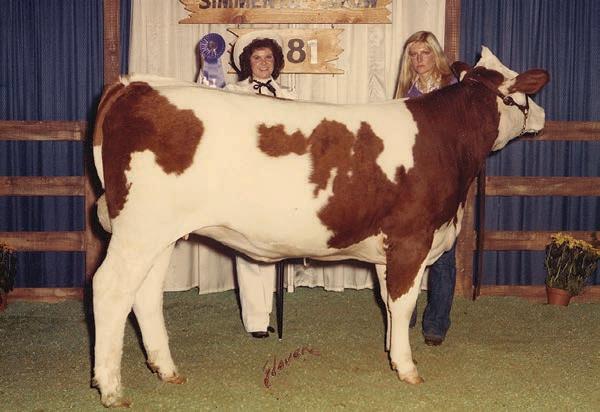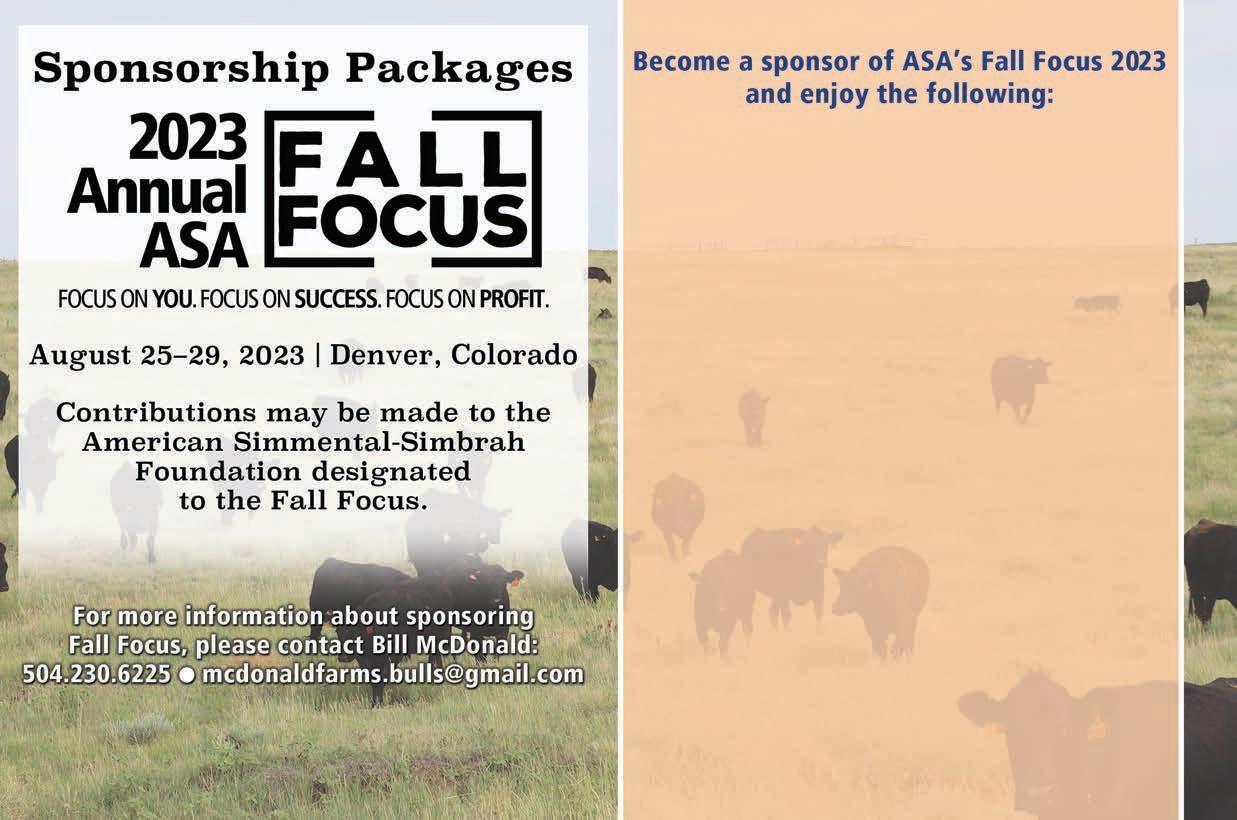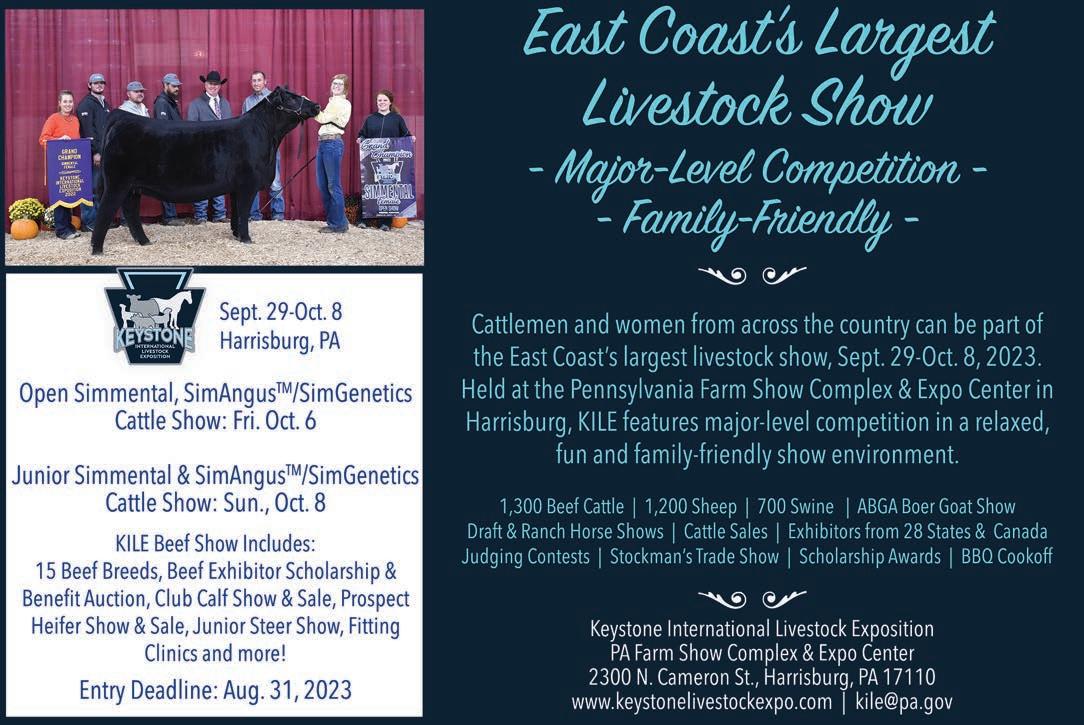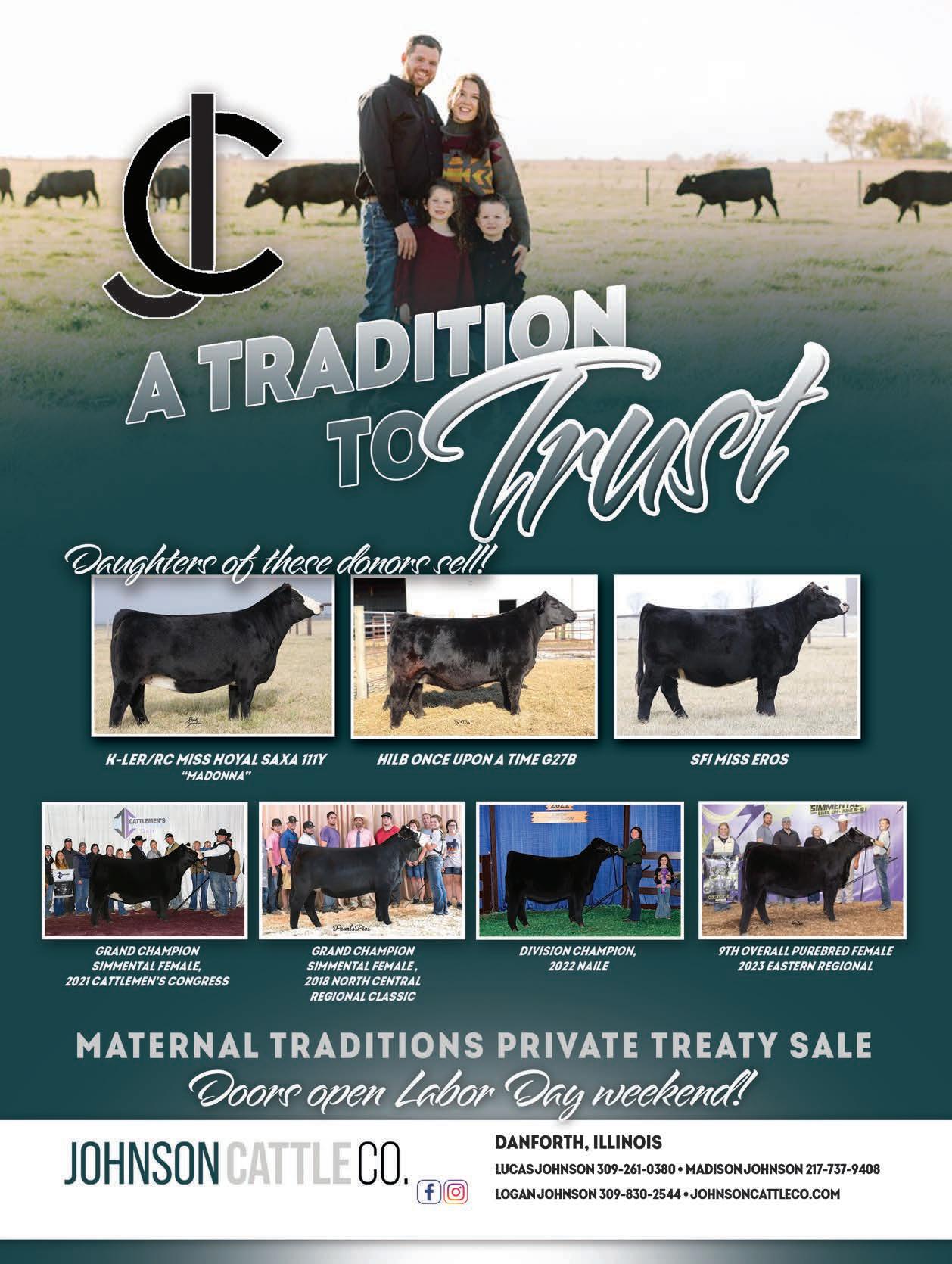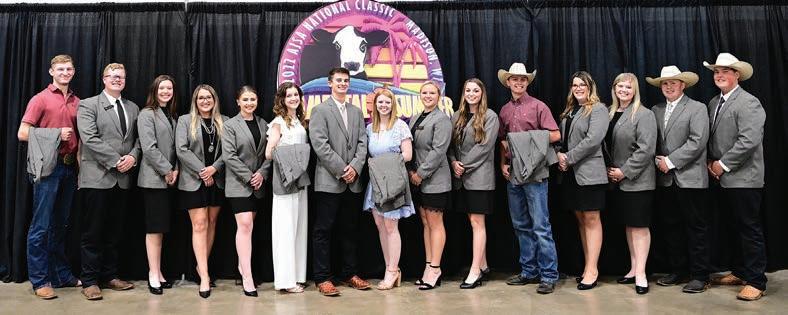
9 minute read
Most Prolific Donor Cows
Hydrops Pregnancies in Simmentals
Seeking reports of active cases
The Nebraska Bovine Congenital Defects program recently recognized an increased number of reports of hydrops pregnancies in a line of Simmental cows. Hydrops is expressed by females developing markedly enlarged abdomens in late pregnancy due to a dramatic excess of fluid in the fetal membranes. At present, these cases point to a genetic link but the pattern of inheritance and percent of affected offspring is unknown. Reports involve daughters and granddaughters of the bull WS All Aboard B80, ASA #2852207.
For the most up-to-date information, please see the “Further Information” link on simmental.org. A webinar discussing what is currently known with the University of Nebraska–Lincoln and ASA team is available at simmental.org. Finally, if you have a potential case to report, please use the “Report Case” link at simmental.org to provide us with your contact information, and a team member will get back to you soon.
Is Your Membership Up To Date?
Has your email address, phone number, or address changed? If so, be sure to get your Herdbook account updated so that you do not miss out on any important information from ASA. This can be done two ways:
1. Log in to Herdbook, go to the “My Account” tab, click on “Update Account,” and update your contact information.
2. Mail or email us a completed Membership Change Form (found at simmental.org, click on “membership”). The form can be emailed to members@simmgene.com.
DNA Updates
DNA Research fee application
DNA research fees are $1/minute and may apply to parentage rechecks, misidentified samples, or other scenarios involving unusual increase in staff time. Each case is unique, so estimating the final charge is difficult. If there are a significant number of animals not qualifying to a parent(s), please reach out to the DNA Department to discuss a rough estimate of time and cost.
Testing Timeline
Allow 4–5 weeks. Please communicate any deadlines you may be working with to the ASA DNA staff. Expedited and tracked shipping is always recommended when ordering kits and shipping samples to Neogen.
$30 DNA Research Fee
Sample packages sent to the ASA office (with or without paperwork), instead of the lab, will incur a $30 research fee. With the exception of research projects (CHR, CCG, CXP), all samples are to be sent directly to the lab with ASA paperwork.
TSU/Applicator Price Increase
Due to rising costs from the TSU manufacturer AllFlex™, ASA has increased the price of TSU sampling kits to $22 per box. Each box still includes ten individual tissue sampling units. The cost of TSU applicators has also been increased from $40 to $50 each.
Semen Sample Fee
Effective immediately, ASA will be implementing a $7.20 processing fee for all semen straws and/or semen samples submitted to Neogen for DNA testing.
Update to HerdBook’s Programming Logic
Purebred Simbrah Classifications
In September of 2022, the ASA Board of Trustees and staff of ASA were notified of a concern regarding the Purebred Simbrah classification some animals received. Upon an in-depth review, ASA determined that the programming logic in HerdBook Services (herdbook.org) from 2013 gave an animal a Purebred Simbrah classification where another interpretation would classify these same animals as Percentage Simbrah.
The ASA Board met on Monday, November 28, 2022, and passed two resolutions that clarified the interpretation of the programming logic to be used for the Simbrah Registry – Breed Classification and provided for the implementation of the clarification.
The updated programming logic was implemented on December 15, 2022, (the “2022 Programing Logic”). This notice is to inform the membership that for some records currently classified as Purebred Simbrah (referred to as the 2013 Programming Logic), the 2022 Programming Logic will classify these same animal records as Percentage Simbrah. To read the full clarification go to simmental.org.
DNA Research Programs Continue
The Calf Crop Genomic (CCG) testing project, and Cow Herd DNA Roundup (CHR) continue to accept new submissions. The CCG offers a 50% off GGP-100K genomic test including parentage ($25 compared to $50 equivalent test) to participating breeders who test their entire calf crop group.
The CHR program also continues to accept new herds. The project tests females at $25 per sample for a GGP100K genomic test. Members must test 90% of their calving-age cows to qualify for the reduced price. When members submit mature cow body weights and body condition scores or hip heights on 90% of their calving-age cows, they will receive a $5 credit to their account for each reported cow. Cows must be 18 months of age or older when mature cow measurements are taken to qualify for the $5 credit. The $5 credit will only be applied once in an animal’s life. For example, if a member received a credit for the phenotypes in 2018 for that cow, they cannot receive another credit for the same cow with a new weight and BCS in 2019.
Additional requirements apply for both programs. Please visit simmental.org, and email researchdna@simmgene.com for full program requirements and more information.
Digital Billing Statements
As of August 1, 2022, members who have provided an email address only receive digital statements. As postal service delays continue to increase, digital statements allow for fast and effective communication. If you did not receive a statement please check your spam folder. Your billing history is available any time through your Herdbook account. Log in, select the My Account tab, select View ASA Billing History, choose the Month and Year and click on Apply. Please log in, go to the My Account tab and make sure the email that is on file is current.
Fourth Quarter Cost-Share Funds Available
The fourth quarter of the 2022–2023 fiscal year ended on June 30. This means that, for those who have not already done so, quarterly Check-Off dollars are available for distribution to state associations. The applications are located on simmental.org. Go to membership → State Associations → Promotional Check-Off Dollar Request. Please do not submit this list by email.
Many state association activities have occurred during these past months. Please submit any pictures or information about these events to editor@simmgene.com to be published in the State Scene section of the Register. Please contact Callie Cooley at stateassoc@simmgene.com if you have questions.
2023 Year-Letter is L
In accordance with the Beef Improvement Federation guidelines, the year-letter animal identification for 2023 is L, and will be followed by M in 2024, and N in 2025. The letter K was the year-letter designated during 2022.
Per the BIF guidelines, the following letters are not used: I, O, Q, and V.
Digital Certificates Available
ASA recently launched a new feature on Herdbook allowing members to download official digital certificates for registered animals. ASA no longer scans and emails or faxes copies of printed certificates, and is encouraging shows, sales, and other events to utilize digital certificates. Digital certificates are the easiest, most reliable way to obtain an official record quickly. To download a digital certificate, search for your registered animal on Herdbook. If you are logged in and the animal is registered in good standing, there will be a button to download a digital certificate. Only the current owner of an animal can access the digital certificate. Please contact the registrations department with any questions at simmental@simmgene.com.
Herdbook Update to Birth Weight Ratio and Collection Method
The ASA Board of Trustees has passed a resolution to change the direction of the ratio for birth weights so that larger ratios are assigned to animals with heavier birth weights in their contemporary group and vice versa. This resolution came about to standardize the direction of the ratios so that higher ratios uniformly mean more of that trait.
Additionally, breeders can now indicate if they use hoof tape to estimate birth weight in Herdbook. There is a column called “BwMethod” next to the column where birth weights are entered in the animal entry page. If the weights were estimated using hoof tape, then simply put a T in the “BwMethod” column. If birth weights were obtained using a scale, there is no need to enter anything.
Office Holiday Schedule
Monday, September 4 Labor Day
Thursday, November 23 & Friday, November 24 Thanksgiving
Monday, December 25 & Tuesday, December 26 Christmas n
by Larry H. Maxey, founder and superintendent, NAILE Fullblood Simmental Shows larryhmaxey@gmail.com
Our Pioneers — Law and Order “Old West Style”
In the 1800s, the Western frontier of what became a huge part of the US was essentially without a formal, organized government. As these lands were brought under the umbrella of our federal government as territories and later as states, an uneasy form of local governance gradually evolved. A roughly 50-year period witnessed the painstakingly slow process of bringing some semblance of order to a vast region where none had existed prior.
I daresay that today you would be hard-pressed to find many of our citizens without any knowledge of the history of our Western frontier, with its infinite stories of hardship. The cowboys, the Native Americans, the great people of a bygone era, and yes, the many accounts of the lawlessness and violence that accompanied that westward expansion as well. I have come to learn that there are conflicting schools of thought about the level of violence and lawlessness: those that contend that the narrative is overblown and those who strongly support it.
One supporting the notion of less conflict and civil unrest than is commonly portrayed was put forth by historian Eugene Hilton. He wrote that the Western frontier “was a more civilized, more peaceful place than American society today” (1974). Terry Anderson and P.J. Hill stated “the West was (wrongfully) perceived as a place of great chaos with little respect for property or life,” and further they contended that “property rights were protected and civil order prevailed” (1979). They credit this orderliness to land clubs, cattlemen’s associations, mining camps, and even wagon trains as substitutes for established government.
My research for recent columns covering John Chisum and The Old Chisholm Trail uncovered many examples of violence, incivility, and lawlessness that would certainly differ from these arguments. Comparing the scale of these accounts to modern-day society should be left to more capable historians. However, from my perspective, ample evidence exists of unscrupulously “bad people” committing heinous crimes regularly. In the Chisum piece, I referenced the infamous “Lincoln County War.” So, what was this “War” and what relevance does it have to the title for this column?
The war began in 1878 and lasted until 1881. It was a conflict between rival factions in Lincoln County, New Mexico Territory, before it became a state. It was made famous from the involvement of the notorious William H. Bonney (born as Henry McCarty) a.k.a. “Billy the Kid.”
The two rivals competed for profits from dry goods and cattle interests in the county. James Dolan maintained a dry goods monopoly through his general store referred to as “The House.” In 1876, the wealthy English-born John Tunstall and his partner Alexander McSween opened a competing store with backing from the famous cattleman John Chisum. Dolan allied with Sheriff William Brady and the Jesse Evans Gang. Tunstall–McSween formed a posse of armed men known as the Lincoln County Regulators. They, too, had lawmen consisting of town constable Richard Brewer and Deputy US Marshall Robert Widenmann.
The war was marked by incredible violence. Revenge killings were the norm. By 1880, most of the original participants were dead from gun violence. With the death of Tunstall, killings went unabated for several months. It all came to a bloody conclusion with the five-day battle of Lincoln, the death of McSween and the scattering of the Regulators. By the war’s end, 23 people lay dead and another 23 were wounded.
The Anderson–Hill perspective described above may have some merit, given the vast expanse of the Western wilderness of the US. That sheer vastness allowed for all sorts of communities to exist with various commercial and communal interests. These communities were perhaps noncompeting and more cooperative where conflict was minimal. However, those non-government “organizations” they cite bear no resemblance to the “organizations” involved in the Lincoln County war and many other conflicts in the Old West. I thus question the sublime theories from the Anderson–Hill conclusions.
The year 1880 brought a new sheriff to town, named Pat Garrett. He was given the mission to hunt down, capture, or kill a large group of “outlaws” responsible for a multitude of crimes as well as their involvement in the Lincoln County War. This group included the infamous “Billy the Kid.” Garrett eventually completed that task although the facts and circumstances surrounding it remain disputed to this day.
Law and Order “Wild West Style” had countless examples of extreme violence and lawlessness similar to the accounts of the Lincoln County War. In the absence of a functioning government, civil society adjusted to ever-changing conditions to survive. The burden of “Law and Order” often fell upon the individual and the rugged individualism that is the cornerstone of this great nation. This is a true testament to the “Pioneers” who took up the 1854 challenge of Horace Greeley when he declared “Go West young man, and grow up with the country”!
Not to readily dismiss the fascinating, yet highly controversial life of Pat Garrett, the next column will attempt to unravel the life and times of this complex man who certainly contributed to bringing law and order to the Old West. n
Editor’s note: This is the thirtieth in the series Our Pioneers.
Is there a Simmental pioneer who you would like to see profiled in this series? Reach out to Larry Maxey or the editor to submit your suggestions: larryhmaxey@gmail.com • editor@simmgene.com


